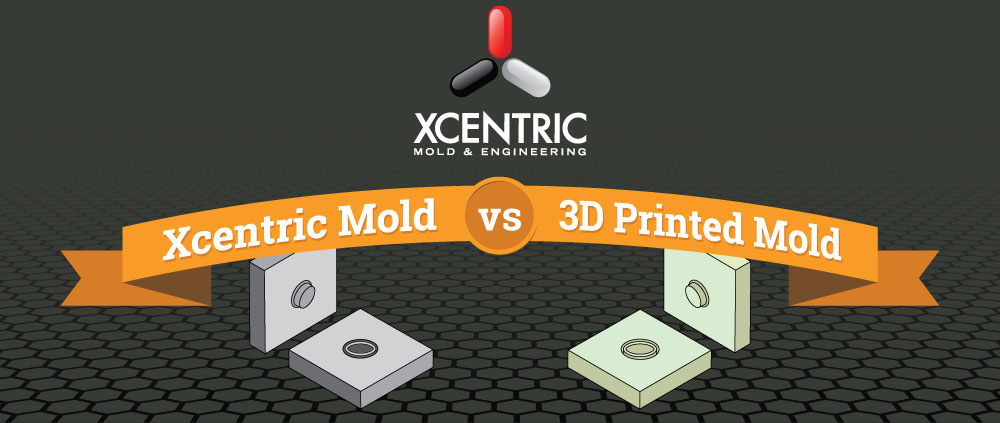
How do 3D printing molds match-up against Xcentric’s Advanced Mold Making and Proprietary Process Engine?
3D printing has come a long way in recent years. According to IBIS World, it is currently a $492.4 million market and is expected to grow by 80% over the next five years. This sort of growth will open up all kinds of new applications for 3D printing. In fact, NASA has already experimented with using this technology with the hope that they can begin to establish on-demand machine shops…in space. We’ll be doing the Kessel Run in under 12 parsecs in no time. 🙂
So, at this point, what can’t 3D printing do?
Well, there’s a movement that is pushing the use of 3D printing for mold making. While it certainly can be done, let’s take a look at why we think this to be more of a novelty than anything else.
- Can’t achieve tight tolerances – 3D printing is still in it’s infancy. You can only achieve a certain amount of detail in the final product and, compared to a metal mold, is nowhere near the tolerances offered. These molds are subject to all the persnickety problems that are inherent to 3D printing too…warping, curling and cracking. If the mold fails to print correctly, you’ll have to throw it out and start again.
- Plastic molds wear easily – Plastic molds begin to show signs of wear after just 10-20 shots and usually become useless after 50. So you can’t even be sure how many parts you can create using that one mold. And once its worn, you are back to reprinting a new one which is subject to all the same pitfalls listed here.
“The number of shots you get from a 3D printed polymer mold is limited.” said Brendan Weaver, President of Xcentric Mold & Engineering. “The 3D printed mold can only take so many squirts and only so much heat and pressure, depending on resin selection. You might be able to get 50 shots off it, but when it goes into a press—to establish a good process—25 to 30 shots are needed to get a good part. By that time, you’ve used up most of the mold’s capability. If you need another 50-100 parts, you need to reprint the entire mold.” - Limitations on resin selection and tolerances – If you need an accurate prototype, a 3D printed mold is too unpredictable to achieve tight tolerances and, unfortunately, there is also a limited selection of resins to choose from. Using a 3D printed mold can provide a prototype, but nothing more. It won’t be an accurate representation with quality materials and it likely won’t be using production quality resins.
 Xcentric Mold Xcentric Mold | FEATURES | 3D Printed Mold |
0.001 – 0.005 | Accuracy |  Unpredictable Unpredictable |
Yes | Design Changes |  No No |
Simple to Complex | Geometry |  Simple Simple |
25,000 + | Tool Life |  50 – if you’re lucky 50 – if you’re lucky |
Thousands | Materials |  Handful Handful |
Any | Finishes |  SPI-C3 only SPI-C3 only |
100% Predictable | Processing |  0% Predictable 0% Predictable |
$ | Cost |  $$$ $$$ |
If you are a DIY’er and want to experiment with 3D printed molds, have at it! It’s an application for 3D printing that works…just not that well. Because if you are looking to get a hundred or more parts made, you’ll have positioned yourself in the market for low-volume production anyway. Why not just skip the hassle of dealing with the issues above and hand the CAD file off to an expert who can get those parts to you even faster?
“If there was a way to implement 3D printing of molds in our current system and realize any benefits, we’d do it. But with our proprietary, advanced mold making technology, we can build a tool complete with heating and cooling in the mold, and get parts into the customer’s hands quicker and at less cost and without the limitations of a 3D-printed mold.”
“We’ll design, build and shoot the mold faster and with no restrictions. And we’ll have already developed a stable process that will replicate production, with real injection molding materials with higher temperatures and pressures,” explained Weaver.
 Xcentric Mold Xcentric Mold | SPEED | 3D Printed Mold |
1 day  | Design Time |  3-5 days – depending on complexity 3-5 days – depending on complexity |
1 day  | Build Time |  1 day – if you own a 3D printer 1 day – if you own a 3D printer |
1 day  | Finish / Assembly |  1-5 days – don’t forget the ejector pins 1-5 days – don’t forget the ejector pins |
1 day  | Run Time |  2 days – limited # of shots 2 days – limited # of shots |
4 days  | Total Time |  7-13 days 7-13 days |
“Remember, it’s not just about making a mold or getting a part. It’s the need to establish a stable production process. A 3D mold printed from a polymer material has limitations with respect to heat, pressure and tolerances, as well as the number of parts it can produce. It’s not giving you any information about a viable process for production.”
Verdict: Printing 3D molds for injection molding produces no benefit when compared to Xcentric’s injection molding process.
Get a quote and experience the difference.
Learn more about how our Advanced Mold Making System and Proprietary Process Engine that makes this possible.
